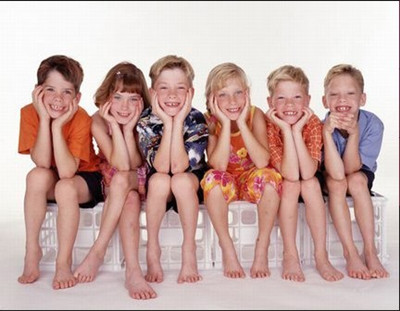多胞胎
Oh, baby
噢,寶貝
A reduction in multiple-birth pregnancies is a good thing
多胞胎懷孕率的減少是件好事
IT HAS long been known that in-vitro fertilisation (IVF) increases the chances of multiple births, as several fertilised eggs are implanted in a woman to improve the chances of pregnancy. A fifth of all successful IVF treatments in Britain result in multiple-birth pregnancies, compared with just over 1% from natural conceptions.
眾所周知體外受精(IVF)可以增加多胞胎幾率,因為要將幾個受精卵植入一個女人體內來提高受孕幾率。在英國,自然分娩多胞胎的幾率僅超過1%,而體外受精的方式則成功的將多胎妊娠的幾率提升到1/5。

Such was the success of IVF after the first test-tube baby was born in 1978 that the rate of all multiple-birth pregnancies rose from ten per 1,000 in that year to 16.4 in 2009. The total number of multiple births doubled during that time. However, for women over 35—frequently users of IVF—it shot up 600%.
自1978年第一例試管嬰兒出生之后,多胞胎受孕率由那一年的千分之十上升到2009年的千分之16.4,這是體外受精的又一成功。多胞胎的總數在那些年間翻了一倍。但是,對于35歲以上的婦女,即體外受精的常見對象,她們生產的多胞胎總數直線上升了600%。
When all goes well, a multiple birth can be good news for women who had difficulty conceiving. But it also carries risks: the infant mortality rate is five times higher than for single births. So the fact that newly released statistics show that the number of multiple births has started to fall is welcome.
當一切都順利的時候,多胞胎對于經歷了痛苦艱難治療的不孕婦女來說無疑是個好消息。但這也同樣帶來危險:多胞胎的嬰兒死亡率比一個嬰兒高五倍。最新發布的統計數據顯示多胞胎的數量正開始降低,這也算是個好消息。
This is largely a result of a new policy adopted by the Human Fertilisation and Embryology Authority (HFEA), a regulator. In 2009 it launched the elective single-embryo transfer policy (now part of its multiple-births minimisation strategy) with the aim of reducing overall IVF multiple pregnancies from 27% in 2008 to 20% initially. HFEA’s latest figures, dating from 2012, show that the rate has slowed to 18%. The current target is 10%. According to the HFEA, multiple-birth pregnancies carry a higher risk of premature delivery and children having disabilities as well as late miscarriage, high blood pressure and pre-eclampsia for expectant mothers. At least that risk is now being tackled for IVF users.
這主要是監管機構人類受精與胚胎管理局(HFEA)執行新政策的結果。2009年它推出了選擇性單個胚胎轉移政策(如今是多胞胎簡化策略的一部分),目的是要將體外受精多胞胎的的總比率由2008年的27%降到最初的20%。HFEA的最新數據顯示,從2012年起,多胞胎比率已經降到了18%。目前的目標是10%。根據HFEA的研究得出,多胞胎懷孕有早產、兒童殘疾的較高風險,并且孕婦有晚期流產、高血壓和先兆子癇的風險。至少現如今IVF受孕對象已經不會被這些風險所困擾了。翻譯:邵夏沁 校對:胡雅琳












